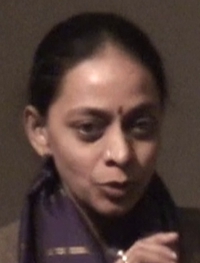
Centre of Jaina Studies Newsletter: SOAS - University of London
Among the pieces that are in the process of being digitally catalogued at the Victoria and Albert Museum are three brass artefacts labeled as 'Jaina'. These once formed part of the collection of Herbert Bradley, part of which was sold to the V&A Museum by his wife, Mrs L.S. Bradley, in 1924. Herbert Bradley initially served as Assistant Collector and finally retired as Chief Secretary to the Government of Madras in 1909. Most of Bradley's artefacts came from the Madras Presidency (one or two from elsewhere in the subcontinent). The then Deputy Keeper of the Indian Section of the V&A, [Caspar] Stanley Clarke, noted in the acquisition file: 'The vendor's husband, an exceedingly shrewd collector, took many years in forming this collection, and by the way, was the first to call the attention of Lord Ampthill to the magnificent South Indian bronzes which are now on loan here' (Records of the V&A Registry). I reproduce here the notes made in the acquisition file for Museum number IM.121-1924: 'Image, brass. A Goddess(?) in the attitude of a standing Jain Tirthankara -?Triśala, the Mother [of] Vardhamana (Mahavira), Jaipur. 18th cent'y...' The words 'Madras Presidency' were inserted below by Stanley Clarke but subsequently struck out. (However, in the Museum Register, it was described more cautiously as 'Figure of one of the attendant yakshinis of Jain tirthankara (?)... may possibly represent Trisala, the mother of Vardhamana.') Similarly, two seated figures were also described as 'Jain': 'Image, brass.?Trisala, seated nude, making mudras. For Jain use. Jaipur; 18th cent'y... IM.122-1924' and 'Image, brass.?Siddhartha, the Father of Mahavira. Seated, nude, making mudras. Jaipur; 18th cent'y. IM.123-1924'. (Again, in the Museum Register, the two figures were described more cautiously as 'possibly' the mother and father of Triśalā.)
On the back of the male image, identified in the file as the father of Mahāvīra, the symbol of a star within a circle and three Tamil glyphs: k, ṅ and r are engraved. This raises the possibility that the statue is Tamil. Considering that Bradley spent almost his entire working life in the Madras Presidency, and a large part of his collection is from this region, this does not seem a far-fetched conclusion. I am tempted to believe that the male and female seated figures represent the Tamil Śaiva bard Sundaramūrti and his wife Paravai nācciyār.

(Left) Female figure, possibly Triśalā or the consort of a Hindu saint, brass, 18th-19th century, Tamil nadu [V&A IM.122-1924]. (Right) Male figure, possibly Siddhārtha or a Hindu saint, brass, 18th-19th century, Tamil Nadu [V&A IM.123-1924]. Images © Victoria and Albert Museum

Female Figure Jaipur, 19th century Brass, cast by the lost wax (cire perdue) process V&A IM.121-1924 Image © Victoria and Albert Museum
Although the pair resemble representations of Mahāvīra's parents, especially in Śvetāmbara iconography, the attributes normally associated with Triśalā and Siddhārtha are missing in these figures. These seem to be processional deities, nude and unadorned, save for distinctive copper bracelets worn on the wrists of both the seated figures, and the female figure's jewellery of sun and moon symbols in her hair. The standing image of what was labeled as "Triśalā or a goddess (?)" again has little to suggest that it is indeed an image of Triśalā, as this is without any adornment or any distinguishing markers.
The apparent use of the kāyotsarga posture is presumably why the standing figure was thought to be Jain. However, it is not entirely clear why the two seated figures were labeled as 'Jaina' or for 'Jain use'. Further study of these objects should help us to make a confirmed identification and also to solve the puzzle of the Tamil glyphs on a presumed "Jaina" piece.

Close-up of Tamil glyphs inscribed behind the seated male figure [IM.123-1924]. Image © Victoria and Albert Museum
 Dr. R. Uma Maheshwari
Dr. R. Uma Maheshwari